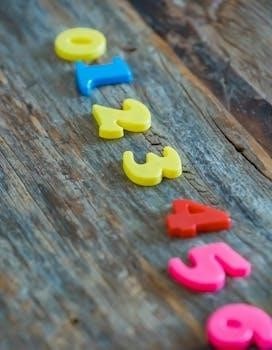PERT Math Practice Test Overview
The PERT math practice test is designed to help students prepare for the actual Postsecondary Education Readiness Test․ These practice tests offer sample questions similar to those on the real exam and will help students familiarize themselves with the test format․ They provide insight into areas needing further study․
What is the PERT Math Test?
The PERT Math Test is a placement exam used in Florida to assess the math skills of incoming college students․ It is part of the Postsecondary Education Readiness Test (PERT) which also includes reading and writing sections․ The math section evaluates a student’s proficiency in various mathematical concepts, including basic algebra, geometry, and more advanced topics such as functions․ This exam helps determine the appropriate math courses for students to take, ensuring they are placed in classes that match their skill level․ The test is computer-adaptive, meaning the difficulty of questions adjusts based on the student’s previous responses․ It consists of 30 multiple-choice questions and is designed to gauge a student’s readiness for college-level math․ The test is used by Florida colleges to place students in suitable math courses․ The PERT math test is a crucial step in a student’s academic journey․
Purpose of the PERT Math Test
The primary purpose of the PERT Math Test is to accurately assess the mathematical abilities of students entering Florida colleges․ This evaluation ensures that students are placed in math courses that align with their current skill level․ Rather than assigning students to courses randomly, the PERT helps identify their strengths and weaknesses in math, which helps avoid enrollment in courses that might be either too challenging or too easy․ The test is used for proper placement, and contributes to the overall academic success of students by ensuring they receive instruction appropriate for their background․ The PERT Math Test is not about pass or fail, but rather a diagnostic tool that provides valuable information for course placement․ The goal is to enhance the educational journey of students by setting them up with the right math classes from the beginning․

PERT Math Test Structure
The PERT math test is one component of a larger assessment․ It is structured to evaluate a student’s math skills through a series of multiple-choice questions․ This section is designed to determine readiness for college-level math courses․
Number of Questions and Sections
The PERT exam, including the math section, is composed of multiple-choice questions․ Specifically, the math portion of the PERT test consists of 30 questions․ These questions are designed to assess a student’s mathematical abilities and readiness for college-level coursework․ The entire PERT exam is divided into three sections⁚ math, reading, and writing; each section contains 30 questions․ Therefore, the total number of questions on the complete PERT exam is 90․ There are no time limits on any individual section, but it typically takes around 3 hours to complete the full test․ The test is also computer-adaptive, which means the difficulty of the questions changes based on the examinee’s previous responses․ This format helps ensure an accurate assessment of a student’s skills․ The math section is not further broken down into smaller subsections, but rather a single group of 30 questions covering a variety of mathematical concepts․ Students should expect to see questions from basic algebra and geometry․

Topics Covered in the Math Section
The mathematics section of the PERT exam is designed to evaluate a student’s proficiency in a range of mathematical concepts necessary for success in college-level courses․ The primary areas covered include basic algebra and geometry․ Specifically, students can expect to encounter questions involving equations, polynomials, and coordinate planes․ The test assesses skills in solving algebraic equations, working with functions, and interpreting graphs․ Furthermore, the math section also tests understanding of fundamental geometric concepts․ These may include questions related to shapes, angles, and spatial reasoning․ The questions aim to gauge a student’s ability to apply these concepts in a variety of problem-solving scenarios․ While the math section is not broken into subsections, the scope of the questions ensures a thorough evaluation of mathematical aptitude․ Additionally, questions may test knowledge of advanced algebra and functions․

Preparing for the PERT Math Test
Effective preparation for the PERT math test involves utilizing various resources such as free practice tests and study guides․ Understanding the test structure and topics covered is also crucial, as is managing time effectively during the exam․
Free Practice Test and Resources
Numerous free resources are available to help students prepare for the PERT math test․ These resources include practice tests, study guides, and sample questions designed to mirror the actual exam’s content and format․ Many websites and educational platforms offer these materials at no cost, allowing students to familiarize themselves with the types of questions they will encounter․ These practice tests often include detailed explanations of the solutions, which can help students understand the underlying mathematical concepts․ Additionally, various online platforms provide video instructions and extra practice questions to solidify knowledge, making them valuable for comprehensive preparation․ Utilizing these free resources is a cost-effective way to identify areas of strength and weakness, enabling focused study․ Students can also find study guides that outline the key topics covered on the PERT math test․ By taking advantage of these free resources, students can significantly improve their chances of success on the PERT exam․
Use of Calculators
The use of calculators on the PERT math test is very limited․ In fact, calculators are generally not permitted for the majority of questions on the math section of the PERT exam․ It is essential for students to understand that they should not rely on a calculator for most of their calculations during the test․ Instead, students must demonstrate their mathematical skills and problem-solving abilities through mental math and manual calculations․ There are only a very few select problems where a calculator is allowed, and these are rare exceptions․ Therefore, it is crucial to prepare for the PERT math test by practicing without a calculator․ Students should focus on building strong foundational skills in arithmetic, algebra, and geometry․ When utilizing practice materials, students must adhere to the no-calculator rule to accurately simulate the testing environment․ This will help them become comfortable with solving math problems without the aid of a calculator and ensure they are well-prepared for the actual exam․
Time Limit Considerations
While the PERT exam does not impose a strict time limit for each section, including the math portion, test-takers should still be mindful of the time they spend on each question․ The entire PERT exam, which includes math, reading, and writing, typically takes around 3․5 hours to complete․ Although there isn’t a specific time constraint for the math section alone, it’s wise to practice efficient time management․ Test takers should aim to complete the 30 math questions within a reasonable timeframe, usually between 45 minutes and one hour․ It is important not to rush through the questions, but also not to get bogged down on a single problem for too long․ Effective pacing is key to completing the math section and the entire exam successfully․ Practice tests can help students gauge how long they take on average to complete the math section, enabling them to develop a realistic time strategy․ It is also important to note that there are no scheduled breaks, so students should plan accordingly to ensure they have adequate time to complete the test․

